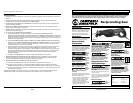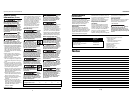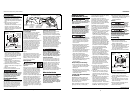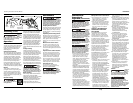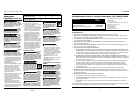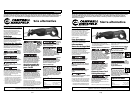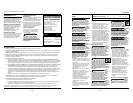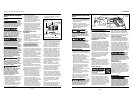
4
8.Resume normal operation.
Before
plugging
in power cord, always pull on the
blade to make sure it is securely locked
in the clamp. Failure to do so may
result in serious injury.
Operation
Power Switch:
To start saw, push in power switch lock
and then squeeze Power Switch with
finger. The maximum speed can be
adjusted with the Variable Speed
Switch (Figure 3).
Speed Control Switch:
The reciprocating saw comes equipped
with a variable speed switch (See Figure
3). This switch is a scroll wheel that has
12 different speed settings. Use lower
speeds for softer, thinner materials and
use faster speeds for harder thicker
materials. Make sure that the saw is on
the minumum speed setting before
turning ON and after each use. Once in
use, scroll the wheel to the preferred
speed. Allow time for the selected speed
to be acquired before beginning cutting.
Blades:
Three different blades have been
packaged with this reciprocating saw.
The blue blade is trypically used for
wook cutting applications, the white
blade is best suited for cutting plastic,
and the red blade is used primarily for
cutting metal.
General Cutting:
Safety glasses must be worn
during operation.
Hold your saw firmly in front and clearly
away from you. Make sure saw blade is
clear of any foreign material and that
power cord and extension cord are out of
the blade path. Be sure material to be cut
is held firmly. Small work pieces should be
securely clamped in a vice or with clamps
to the work bench or table. Mark the line
of cut clearly. Pull in the power switch to
start the cutting action. Set the blade
guard on the work. DO NOT FORCE. Use
only enough pressure to keep the saw
cutting. Allow the blade and saw to do the
work.
Plunge Cutting:
Clearly mark the line of cut. From a
convenient starting point within the cut
out area, place the tip of the blade over
that point with saw parallel to the line of
cut. Slowing lower the saw until the
button edge of the shoe rests on the
work-piece. Start the saw and allow it to
attain full speed. With the saw resting on
the blade guard, slowly let the saw
forward to lower the blade onto the cut
line. Continue this motion until the saw
blade is perpendicular to the work-piece.
Make
sure the
blade does not touch the workpiece
until the saw reaches its maximum
speed that is set on the speed Adjust
Dial. Failure to comply could cause loss
of control and result in serious injury.
Metal Cutting:
When cutting metallic material with this
tool, be sure to use a sharp blade
designed for this purpose. We recommend
lubricating the cutting surface with
cutting oil to avoid heat buildup. Follow
general cutting procedure in previous
section. Do not force tool. Use only
enough pressure to keep the saw cutting.
Maintenance
Do not
allow
brake-fluids, gasoline, petroleum-based
products penetrating oils, etc. to come in
contact with plastic parts. They contain
chemicals that can damage, weaken or
destroy the housing, thus compromising
the integrity of the double insulation.
Keeping the Tool Clean:
All plastic parts should be cleaned with
a soft damp cloth. NEVER use solvents
to clean plastic parts. They could very
possibly dissolve or otherwise damage
the material.
Inspecting the mounting screws:
Regularly inspect all mounting screws
and ensure that they are properly
tightened. Should any of the screws be
loose, tighten them immediately.
Failure to do so could result in serious
injuries.
Maintenance of the motor:
The motor unit winding is the very
“heart“ of the power tool. Exercise
due care to ensure the winding does
not become damaged and/or wet with
oil or water.
Inspection the carbon brushes:
The motor employs carbon brushes
which are consumable parts. Since an
excessively worn carbon brush could
result in motor trouble, replace the
carbon brush with an identical part
when it becomes worn to or near the
limit. In addition, always keep carbon
brushes clean and ensure that they
slide freely with in the brush holder.
Technical Service:
For information regarding the
operation or repair of this product,
please call 1-800-424-8936.
Tool
service
must be performed only by qualified
repair personnel. Service or maintenance
performed by unqualified personnel
could result in a risk of injury.
13 Sp
Store idle
power
tools out of the reach of children and
do not allow persons unfamiliar with
the power tool or these instructions to
operate the power tool. Power tools
are dangerous in the hands of
untrained users.
Maintain
power
tools. Check for misalignment or bind-
ing of moving parts, breakage of parts
and any other condition that may affect
the power tool’s operation. If damaged,
have the power tool repaired before
use. Many accidents are caused by poor-
ly maintained power tools.
Keep
cutting
tools sharp and clean. Properly main-
tained cutting tools with sharp cutting
edges are less likely to bind and are
easier to control.
Use the
power
tool, accessories and tool bits etc. in
accordance with these instructions,
taking into account the working condi-
tions and the work to be performed.
Use of the power tool for operations
different from those intended could
result in a hazardous situation.
• Cuando esté efectuando un trabajo
por el cual la herramienta de corte
puede entrar en contacto con un
cable eléctrico oculto o su propio
cable, sujete la herramienta eléctrica
por las superficies de sujeción
aisladas. El contacto con un cable
“bajo tensión” pone las piezas
metálicas de la herramienta “bajo
tensión" y causa un choque eléctrico
al operador.
• Asegúrese de que el interruptor esté en
la posición de apagado (OFF) antes de
conectar la herramienta a la fuente de
corriente. Hacerlo con el interruptor en
la posición de encendido (ON) puede
hacer que se encienda accidentalmente.
• Use solamente accesorios
recomendados por el fabricante de
su modelo. Los accesorios apropiados
para una herramienta pueden causar
un riesgo de lesión cuando se usan
con otra herramienta.
• Algunas maderas contienen
conservadores que pueden ser
tóxicos. Tenga especial cuidado para
evitar la inhalación y el contacto con
la piel con estos materiales. Solicite y
cumpla con toda la información de
seguridad disponible por parte de su
proveedor de materiales.
Manejo de la sierra alternativa:
• No encienda la sierra si la hoja toca
alguna superficie. La hoja hará
rebotar la herramienta y podría
causar lesiones personales.
• Deje que la herramienta se detenga
por completo antes de soltarla. Una
herramienta en funcionamiento se
sacudirá cuando la punta de la hoja
entre en contacto con cualquier
superficie.
CAUSAS Y PREVENCIÓN DEL
CONTRAGOLPE POR PARTE
DEL USUARIO:
El CONTRAGOLPE es una reacción
repentina de una hoja de sierra
mordida, atascada o mal alineada,
provocando que una sierra fuera de
control se levante y salga de la pieza
de trabajo hacia el operador.
Cuando la hoja esté mordida o atascada
firmemente por la entalla o ranura de
corte, cerrándose, la hoja se parará y la
reacción del motor impulsará la unidad
rápidamente hacia el operador.
Si la hoja se tuerce o se desaliña en el
corte, los dientes del borde posterior
de la hoja pueden perforar la
superficie superior de la madera
provocando que la hoja se zafe de la
entalla y salte hacia el operador.
El CONTRAGOLPE es el resultado de un
mal uso de la herramienta y/o de
procedimientos o condiciones de
funcionamiento incorrectos y puede
evitarse tomando las precauciones
necesarias que se proporcionan a
continuación:
1.Sostenga la sierra con firmeza con las
dos manos y posicione su cuerpo y
brazo de un modo que le permita
resistir las fuerzas de CONTRAGOLPE.
El operador puede controlar las
fuerzas de CONTRAGOLPE si toma las
precauciones necesarias.
2.Cuando la hoja se atasque, o cuando
se interrumpa el corte por algún
motivo, libere el gatillo y sostenga la
sierra sin moverla sobre el material
hasta que la hoja se detenga por
completo. Nunca intente retirar la
sierra del trabajo ni tirar la sierra
hacia atrás mientras la hoja esté en
movimiento o puede haber un
CONTRAGOLPE. Investigue y tome
acciones correctivas para eliminar la
causa del atascamiento de la hoja.
3.Cuando reinicie una sierra en la pieza
de trabajo, centre la hoja de la sierra
en la entalla o corte y verifique que
los dientes de la sierra no queden
enganchados en el material. Si la
hoja de la sierra está atascada, puede
salirse o provocar un CONTRAGOLPE
desde la pieza de trabajo mientras se
reinicia la sierra.
4.Apoye bien los paneles grandes para
minimizar el riesgo de morder la hoja
y de CONTRAGOLPE. Los paneles
grandes tienden a curvarse por su
propio peso. Se deben colocar apoyos
a ambos lados debajo del panel,
junto a la línea de corte y cerca del
borde del panel.
5.No utilice hojas desafiladas ni
dañadas. Las hojas desafiladas o en
mal estado producen que la entalla
se angoste causando fricción
excesiva, atascamiento de la hoja
y CONTRAGOLPE.
6.Tenga extremo cuidado al hacer
un “Corte en bolsillo” en paredes
existentes u otras áreas ciegas.
La hoja que sobresale puede cortar
objetos que pueden causar
CONTRAGOLPE.
7.La guarda de la hoja puede ajustarse
para limitar la longitud expuesta de
la hoja. Asegúrese de que la hoja sea
suficientemente larga o la guarda de
la hoja sea ajustada para permitir
que la hoja se extienda más del
grosor del material. Si la hoja es
demasiado corta, eso aumenta la
posibilidad de CONTRAGOLPE. Antes
de cortar, asegúrese de que los
tornillos de la hoja estén apretados.
8.Fije la profundidad de corte para
no más de 1/8" a 1/4" más del grosor
del material. Cuanto menos hoja
quede expuesta, habrá menos
probabilidades de atascamiento
y CONTRAGOLPE. Antes de cortar,
asegúrese de que los ajustes de
profundidad y de corte en diagonal
estén firmes.
9.Tenga cuidado con los materiales
inclinados, nudosos, húmedos o
deformados. Es muy probable que
estos materiales creen condiciones
de mordida y posiblemente
CONTRAGOLPE.
SERVICE
Have you
power
tool serviced by a qualified repair per-
son using only identical replacement
parts. This will ensure that the safety
of the power tool is maintained.
Al realizarle un servicio a las
herramientas, utilice únicamente
piezasde repuesto idénticas. Siga las
instrucciones de la sección
Mantenimiento de este manual. El uso
de piezas no autorizadas o el no seguir
las instrucciones de Mantenimiento
puede crear un riesgo de choque
eléctrico o lesión.
DG420700CK
Operating Instructions and Parts Manual
Informaciones
Generales de
Seguridad (continuación)
Figure 3
Power switch
Lock
Variable Speed Switch
Power
Switch
Blade
Guard
Warning Decal
(opposite side)
Blade retainer screw
access hole
Blade Guard
Adjustment
Screws (2)
Assembly (cont’d.)



